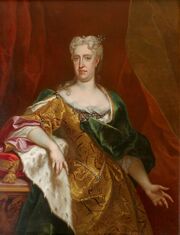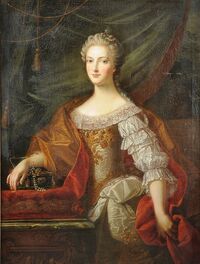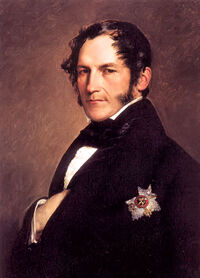| Kingdom of Flanders Koninkrijk Vlaanderen Timeline: Cromwell the Great
Royaume de Flandre (French) Königreich Flandern (German) OTL equivalent: Flanders and Luxembourg | |||||
|---|---|---|---|---|---|
|
|||||
| Motto: Pro aris et focis (Latin: For altars and hearths) |
|||||
| Anthem: La Brabançonne |
|||||
| Capital | Brussels | ||||
| Largest | Antwerp | ||||
| Other cities | Ghent, Bruges, Luxembourg and Ostend | ||||
| Official languages | Dutch (official) and French (administrative language) | ||||
| Local | German, Luxembourgish, Spanish and Latin | ||||
| Religion | Roman Catholic (official)
Protestant and Judaism |
||||
| Demonym | Flemish | ||||
| Government | Monarchy. State of the Holy Roman Empire (1715-1805), Constitutional monarchy (1805 to date) | ||||
| - | Queen[1] | Louise-Marie | |||
| - | Governor-General | Albert Tielemans | |||
| Legislature | General States of Flanders | ||||
| Establishment | |||||
| - | Independence from Spanish Netherlands | 1715 | |||
| - | Grand Duchy | 1715-1805 | |||
| - | Kingdom | 1805 to date | |||
| Currency | Flemish gulden | ||||
| Time zone | GMT0 | ||||
| Date formats | dd/mm/yyyy (AD) (civil calendar) | ||||
| Drives on the | right | ||||
| Membership international or regional organizations | Congress System (observer and guest) | ||||
Numquid regnabis quoniam confers te cedro? pater tuus numquid non comedit et bibit, et fecit judicium et justitiam tunc cum bene erat ei?
Judicavit causam pauperis et egeni in bonum suum: numquid non ideo quia cognovit me? dicit Dominus.
(Ieremias 22:14-15, Biblia Sacra Vulgata)
The Kingdom of Flanders is an independent state that borders the Dutch Republic and France.
Summary[]
From 1715 to 1805 Flanders was a Grand-Duchy[2]. The Grand Duchy was a non-contiguous territory bisected by the Prince-Bishopric of Liège that separated the south of the Grand Duchy (Luxembourg, Limburg and Guelders) from the northern lands until the Treaty of Aix-la-Chapelle (1748). By this treaty the Prince-Bishopric of Liège was partially integrated to the Grand-Duchy a condominium. Liège was annexed during the European Revolutionary Wars. On the dissolution of the Holy Roman Empire in 1805 it was proclaimed as a Kingdom.
The Grand-Duchy (1715-1805)[]

Flag of the Grand-Duchy of Flanders

Coat of Arms of the Grand-Duchy of Flanders
Flanders was created after the War of the Spanish Succession (1702–1715). It is composed of the states of the Holy Roman Empire in the Low Countries, formerly held in personal union by the Spanish Crown (also called Habsburg Spain).
During the War of the Spanish Succession Flanders became an Anglo-Dutch condominium for the remainder of the conflict. By the peace treaties of Utrecht and Rastatt ending the war, the Southern Netherlands gained autonomy and was detached from the Spanish Crown under the rule of a branch of the Austrian Habsburgs. Officially raised to Grand-Duchy within the Holy Roman Empire by Emperor Charles VI who also named his sister Archduchess Maria Elisabeth as its first ruler.
The Barrier Treaties, signed and ratified during or immediately after the War of Spanish Succession secured the Dutch Republic and Flanders against French aggression. The treaties referred to several fortresses within the territory of Flanders, that were in effect garrisons manned with Dutch troops acting as forward bases buffering the Dutch Republic from the Kingdom of France.
Also a naval treaty between Flanders, Dutch Republic and the Commonwealth provided for the unlimited used of ports in Flanders as part of the defense against France in exchange of free navigation for Flanders of the River Scheldt giving Antwerp access to the sea again.
Grand-Duchess Maria Elisabeth of Austria[]

Archduchess Maria Elisabeth of Austria. Grand-Duchess of Flanders (1715-1756)
The Grand-Duchess Maria Elisabeth was well educated and fluent in Latin, German, French and Italian and later also Dutch. Maria Elisabeth was described as a forceful administrator and a popular ruler. With great powers, she ruled the Flanders with relative absolutism and held a large court, but was popular among other things for her piety and poor care. Her independent politics, however, were not always appreciated in Vienna. Under the rule of Archduchess Maria Elisabeth the court of Brussels at Palace of Coudenberg gathered an impressive artistic and intellectual level thanks to royal and noble patronage. The during her reign it was finish the construction and inauguration of the Grand Ducal Opera.
Among her subjects she very popular because of her piety as well as care for the needy and the sick. She attended religious festivals and took part in pilgrimages. Annually she washed 12 poor old women on Maundy Thursday, entertained and equipped them with new clothes. In church politics she led a struggle against Jansenism.
Maria Elisabeth commissioned the first systematic investigations on the local industry and farming to explore opportunities for reform and improvement. Besides chartering the Ostend Company, one of her lasting legacies, she also become a shareholder of it and defended against pressures from the Dutch and British to disband it.
Maria Elisabeth never married and on her death (1756) and according to her will, she was succeed by her niece the archduchess Maria Anna Eleanor of Austria (1718-1780).
Grand-Duchess Maria Anna Eleanor of Austria[]

Archduchess Maria Anna Eleanor of Austria, Grand-Duchess of Flanders
The archduchess Maria Anna Eleanor of Austria, daughter of Charles VI Holy Roman Emperor, arrived along her husband Prince Charles Alexander of Lorraine to Brussels opening a new age. The Grand-Duchess and her husband brought with them the sophistication of the Viennese Court and enlightened despotism as style of rule.
Charles Alexander of Lorraine, besides being her husband was also an important advisor and co-ruler. Though an unsuccessful military leader, Charles proved to be a competent administrator, well-liked by the population. Under him, Flanders flourished, and he was deeply involved in the cultural life of the Grand-Duchy. Establishing the Flemish Academy of Science, Letters and Fine Arts (1770).
Becoming a British ally, along the Dutch Republic, in the War of the Austrian Succession (1740–48) enable it to have closer with these three countries that enable it to access to British and colonial markets and also the new steam technologies and investments. The literary salons (Salonnières) of Brussels, Antwerp and Ghent also become popular when French royal edicts restricted their sessions in Paris attracting French exiles, Flemish aristocracy, British and Dutch expatriates.
The Grand-Duchess by the Treaty of Aix-la-Chapelle (1748) gained influence of the Prince-Bishopric of Liège and in short time by numerous decrees and bilateral treaties became a full part of Flanders except de jure and in name.
The Jolly Grand-Duchess Anne-Charlotte[]

Grand-Duchess Anne-Charlotte of Flanders (1758-1818) Reign 1780-1818
Archduchess Maria Anna Eleanor's older daughter, Anne-Charlotte (1758-1818), became the Grand Duchess at her death in 1780. Anne-Charlotte, also known as the joyeuse Grande-duchesse (Jolly Grand Duchess). During her reign royal public appearances were frequent and became part of the agenda. She also had the habit of treating all people the same, regardless of their social status. Important acts of diplomacy were her two state visits to the Dutch republic and her week long state visit to Britain.
Grand-Duchess Anne-Charlotte reined in an epoch of remarkable social and economical transformations of Flanders due to the industrial revolution and also the political turmoil of the French revolution.
She enacted Flanders' first constitution establishing a semi parliamentary monarchy in 1788. It was based on Dutch practices reforming the electorate of the General States of Flanders. The General States gained the right to address and petition the Governor-General and the Supreme Council on all affairs of the Grand-Duchy. The territories of Liège gained a delegation to the General States.
During the European Revolutionary Wars Flanders was invaded by the French Republic in the beginning of the German campaign under the command of General Hoche. Grand-Duchess and government were forced to flee to Britain. During the brief eight month truce the Grand-Duchess returned in November 1802. The Grand-Duchess Anne-Charlotte addressing the welcoming crowd in front of the Place Royale promised to call a Constituent Assembly. Again forced to flee in May 1803 to Britannia due to the restart of hostilities. With the dissolution of the Holy Roman Empire in 1805 the Grand-Duchess proclaimed the establishment of the Kingdom of Flanders.
On returning in 1810 she again address the crowd at Place Royale. Remembering her previous promise and saluting the men and women, all patriots, that defended with their lives the freedom of Flanders she bowed with her head inclined to the cheering crowd and rose declaring that As your sovereign and now a citizen. I am now bound by your will.. Thus began the parliamentary monarchy began in Flanders under the Citizen-Kings (Rois Citoyen).
Economic rebirth and industrial revolution[]
The port of Antwerp flourished again thanks to the reopening of the river Scheldt. Although Flanders could never seriously compete with the Dutch it lost its industrial stagnation and became an important entrepot of the Holy Roman Empire. At times it was at odds with the economical interests of Habsburg Austria.
Unlike its neighbour, the Dutch Republic, Flanders was an early adopter steam-power based industrial revolution mainly because it had local availability of coal and iron. However it lacked capital and technology. Tough, during the 18th century numerous works comprising coke blast furnaces as well as puddling and rolling mills were built in the coal mining areas with the help of Dutch capital and English technology.
The Ostend Company[]

Flag of the City of Ostend used by the vessels of the chartered company.
The success of the Dutch, British and French East India Companies led the merchants and shipowners of Ostend in Flanders (part of the Holy Roman Empire) to want to establish direct commercial relations with the Indies. The trade from Ostend to Mocha, India, Bengal and China started in 1715. Some private merchants from Antwerp, Ghent and Ostend were granted charters for the East India trade. Between 1715 and 1723, 34 ships sailed from Ostend to China, the Malabar or Coromandel Coasts, Surat, Bengal or Mocha. Those expeditions were financed by different international syndicates composed of Flemish, English, Dutch and French merchants and bankers.
To end rivalries that weighed heavily upon the profits and promote local merchant interests that a chartered company was formed. The Ostend Company[3] was established in 1722 as chartered company to trade with the East and West Indies. Its shares were hold by merchants, shipowners and bankers from Antwerp, Ghent, Ostend and Brussels. Though not as profitable as its Dutch and English rivals it gave its shareholders and traders a 15 percent return on their shares. Tea, coffee, sugar and spices were the main commodities the company traded in the Flanders and the Holy Roman Empire. The company also became the official Imperial provider of silk in Vienna.
In order to attract foreigners with experience, the Ostend company allowed them generous allowances in terms of cargo space for private trade, something that was anathema to the existing monopolistic companies.
The company possessed three factories (trading posts), at Cabelon (modern-day Covelong) on the Coromandel Coast and Banquibazar (Ichapore) in Bengal and Mocha in Yemen. In 1785 the Company acquired the Nicobar Islands from Denmark–Norway established a colony and trading factory on the island of Nancowery,
Government of Flanders[]
Grand Duchy of Flanders (1715-1805)[]

King Leopold I of Flanders (1778-1826) Reign 1818-1826
The Grand-Duchess as most of the rulers of Flanders are women, governed thru an appointed Governor-General (Gouverneur-Generaal) and the Supreme Council. The Grand-Duchess had far-reaching powers. She can appoint prelates independently, most of the members of the states of the individual provinces and members of the Great Council as well as of the Collateral Councils and grant to amnesty and pardon. Along a generously funded civil list.
The governor-general and council are in charge of the superior administration of all the affairs of Flanders, maintenance of the Catholic religion, execution of the laws, and administration of justice by the courts and judges. The governor-general personally oversees justice, police and finance.
As a concession to local autonomy and historical charters a reformed General States of Flanders (États généraux de Flandre) was established. The General States represented the interest of the provinces of Flanders and advised the Grand-Duke/Grand-Duchess and the Supreme Council of State.
By Treaty of Aix-la-Chapelle (1748), the Grand-Duchess also personally held the position of consulting regent of the Prince-Bishopric of Liège. In practical terms it partially blocked the movement of French troops to Germany and the Netherlands and neutralized Flanders in case of war. However during the European Revolutionary Wars Liège rebels deposed the conservtive Prince-Bishop and declare the Liège Republic. Despite declaring Liège neutral it was occupied by the French Army and its authoritative removed and an allied pro-French government was placed and later directly annexed to France. The Treaty of Vienna (1810) officially recognised Liège as part of Flanders.
Kingdom of Flanders (1805 to date)[]
On the dissolution of the Holy Roman Empire in 1805 the Grand-Duchess Anne-Charlotte proclaimed the establishment of the Kingdom of Flanders. As part of the reformist zeal of Anne-Charlotte a constituent assembly was called but the __?__ postponed its election. Only in 1810 and after regaining its independence was the Flemish Constituent Assembly called and elected. Using as models the constitution of the Commonwealth and the Netherlands the Constitution of 1811 established a parliamentary monarchy, or a popular monarchy as stated in in its preamble and organization of powers. The Citizen-King of Flanders as the head of state, and the Governor-General of the State Council is the head of government. The government is named by the Citizen-King based on the leader of the majority party or coalition in the General States.

Louise-Marie of Flanders (1804-...) Reign 1826-...
- Territory of Flanders
- general governors jointly named by the Commonwealth and Dutch Republic.
- Grand-Duchess of Flanders[4].
- Archduchess Maria Elisabeth of Austria (1680 –1756) Reign 1715-1756
- Archduchess Maria Anna Eleanor of Austria (1718-1780) Reign 1756-1780
- Anne-Charlotte (1758-1818) Reign 1780-1805
- King/Queen of Flanders
- Anne-Charlotte (1758-1818) Reign 1805-1818
- Leopold I (1778-1826) Reign 1818-1826
- Louise-Marie (1804-) Reign 1826-
- Governor General
- Prince Eugene of Savoy 1715-1715
- Dominik von Königsegg-Rothenfels 1715-1716
- Hercule-Louis Turinetti, marquis of Prié 1716-1724
- Count Wirich Philipp von Daun 1724-1724
- Direct rule / Gran-Duchess Maria Elisabeth of Austria 1724-1726
- Giulio Visconti Borromeo Arese 1726-1732
- Friedrich August de Harrach-Rohrau 1732-1744
- Wenzel Anton 1744-1746
- Karl Josef Batthyány 1748-1749
- Antoniotto Botta Adorno 1749-1753
- Johann Karl Philipp von Cobenzl 1753-1765
- Prince Charles Alexander of Lorraine 1765-...
Provinces and other territories[]

Provinces of the Gran-Duchy of Flanders
Constituent states of the Grand Duchy of Flanders. These would later become, including Liege, provinces
- Duchy of Brabant
- Margraviate of Antwerp
- Duchy of Limburg
- Duchy of Luxembourg
- The Upper Quarter (Bovenkwartier) of the Duchy of Guelders
- County of Flanders
- County of Namur
- County of Hainaut
- Lordship of Mechelen
- The Tournaisis
- It also includes the
Prince-Bishopric of Liège. Since 1748 condominium of the Grand-Duchy of Flander and the Price-Bishop of Liege.
The administrative reform of 1812 created the following provinces:
- Antwerpen / Antwerp
- Brabant
- East Flanders
- West Flanders
- Hainaut
- Limburg
- Liège
- Luxembourg
- Namur
- Utrecht
| |||||||||||||||||||||||
- ↑ House of Habsburg (1715-1756), Habsburg-Lorraine (1756 to date)
- ↑ Groothertogdom Vlaanderen (Dutch)
Grand-Duché de Flandre (French)
Grossherzogtum Vlaanderen (German)
Gran Ducado de Flandes (Spanish) - ↑ (Dutch: Oostendse Compagnie, or Generale Indische Compagnie, French: Compagnie d'Ostende or Compagnie générale des Indes)
- ↑ Also since 1748 consulting regent of the Prince-Bishopric of Liège



